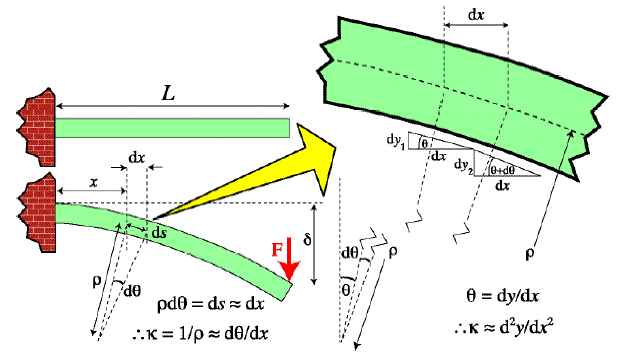Beam deflection during cantilever bending
The beam curvature, κ, is approximately equal to the curvature of the line traced by the neutral axis, d2y/dx2 (see diagram below), so that
\[\frac{{{{\rm{d}}^2}y}}{{{\rm{d}}{x^2}}} = \kappa = \frac{M}{{EI}}\]
where M is the bending moment, E is the Young's modulus and I is the second moment of area. Applying this to the end-loaded cantilever beam, and taking the moment as positive when it generates a displacement in the downward direction (+ive y)
\[EI\frac{{{{\rm{d}}^2}y}}{{{\rm{d}}{x^2}}} = M = F\left( {L - x} \right)\]
where F is the load applied at the end of the beam.
Approximation involved in equating beam curvature to the curvature of the neutral axis (Click on image for larger version)
The deflection is found by integrating this expression, using boundary conditions to establish the integration constants
\[EI\frac{{{\rm{d}}y}}{{{\rm{d}}x}} = FLx - \frac{{F{x^2}}}{2} + {C_1}\] \[{\sf{at }}\;x = 0, \frac{{{\rm{d}}y}}{{{\rm{d}}x}} = 0, \sf{thus}\; {C_1} = 0\]
\[EIy = \frac{{FL{x^2}}}{2} - \frac{{F{x^3}}}{6} + {C_2}\] \[{\sf{at }}\;x = 0, y = 0, \sf{thus}\; {C_2} = 0\]
The deflections along the length of the beam, and specifically at the loaded end, are thus given by
\[y = \frac{{F{x^2}}}{{6EI}}\left( {3L - x} \right)\] \[\delta = \frac{{F{L^3}}}{{3EI}}\]


